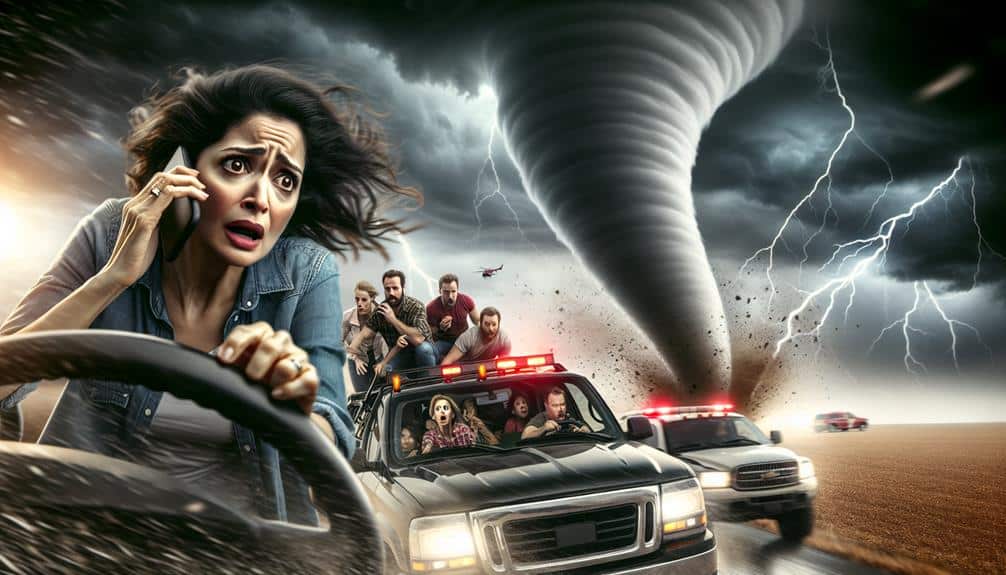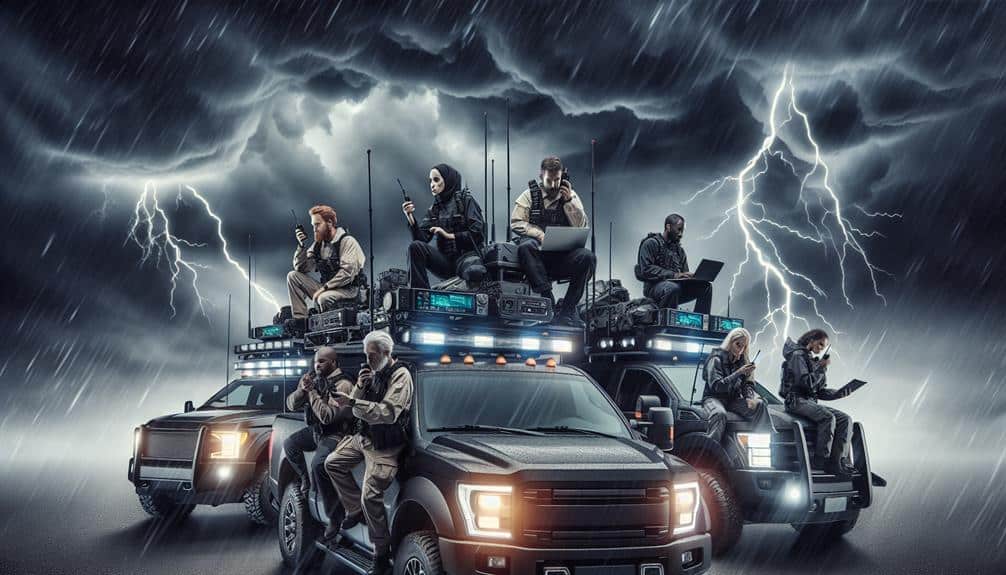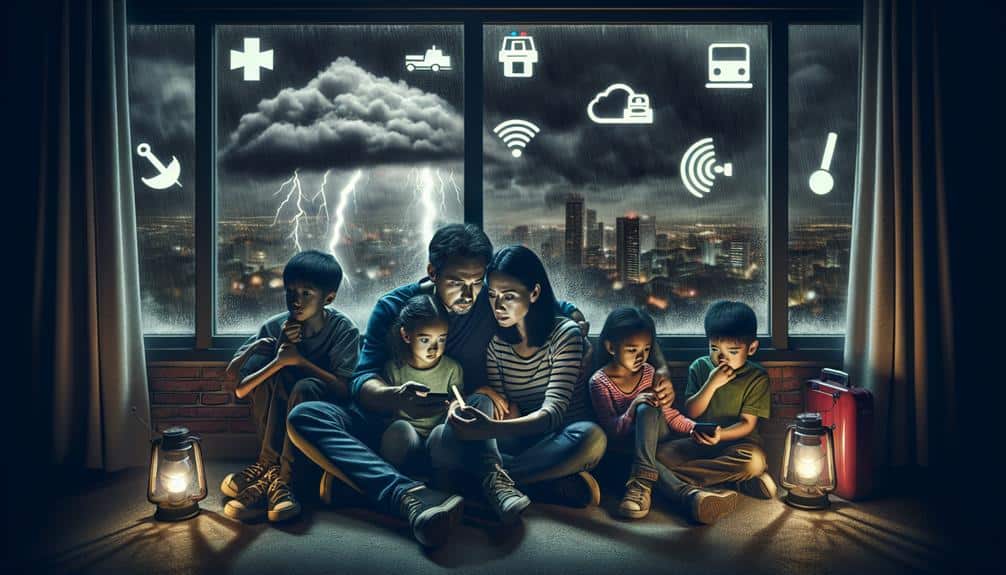We need to establish clear communication protocols and designate primary and secondary methods for relaying information in emergencies. Let's invest in high-quality communication gear, prioritize battery life, and guarantee robust signal strength. Regularly scheduled updates and using multiple channels keep everyone informed. We should share accurate location data with GPS and coordinate closely with local authorities, using clear language. Leveraging social media can help distribute rapid, real-time updates. By following these tips, we'll secure safety and efficiency during storm chasing emergencies. If we explore further, there are additional strategies to enhance our emergency communication systems.
Key Points
- Use high-grade communication gear with robust signal strength and long battery life.
- Establish clear communication protocols with predefined strategies and designated methods.
- Maintain regular updates and share real-time safety information through multiple channels.
- Coordinate with local authorities and use clear, concise language for safety updates.
Establish Clear Protocols
Let's establish clear protocols to guarantee effective communication during storm-chasing emergencies. First, we need predefined communication strategies to guarantee everyone knows what to do in critical moments. These strategies should include a mix of verbal and non-verbal signals, considering that traditional communication channels might fail during severe weather conditions.
We should designate primary and secondary communication methods, such as radios for primary and satellite phones for backup. Each team member must be trained to use these devices efficiently. In our emergency response plan, we should have specific codes for different scenarios, such as 'Code Red' for immediate danger or 'Code Green' when it's safe to proceed.
A critical component of effective communication is regular check-ins. We can set intervals, like every 15 minutes, to update our location and status. This guarantees that any team member who doesn't report on time is quickly identified, allowing us to respond appropriately.
Lastly, let's create a centralized communication hub. A designated team leader should monitor all communication channels and coordinate our moves. By adhering to these protocols, we're ensuring our safety and freedom to chase storms with minimal risk.
Use Reliable Equipment
We must invest in quality gear to guarantee our communication devices function under extreme conditions.
Prioritizing battery life is important, as our equipment needs to operate for extended periods without recharging.
Additionally, we should confirm signal strength remains robust to maintain clear and reliable communication.
Invest in Quality Gear
Investing in high-grade, dependable communication gear is essential for storm chasers to guarantee safety and efficiency during emergencies. We can't afford to take risks with subpar equipment when lives are at stake. Premium radios, satellite phones, and ruggedized laptops are necessary tools in our arsenal. These devices ensure we maintain critical lines of communication, even in the harshest conditions.
We must also prioritize gear maintenance as part of our routine. Regularly inspecting and servicing our equipment reduces the risk of unexpected failures. This includes checking for software updates, inspecting physical wear and tear, and verifying all components are functioning correctly. Preventive maintenance is a key aspect of our emergency preparedness strategy, ensuring our gear is always in peak working condition.
Data from the National Storm Chasers Association indicates that chasers using top-tier communication equipment experience 50% fewer communication breakdowns during storms. This is a significant advantage in scenarios where every second counts.
Prioritize Battery Life
Maintaining communication gear is only half the battle; making sure our devices have sufficient battery life during emergencies is equally crucial.
We need to maximize efficiency by using reliable equipment with long-lasting batteries. Lithium-ion batteries are preferred due to their high energy density and longer life cycles. Devices equipped with power-saving modes help us conserve power by reducing unnecessary energy consumption.
To extend battery life, disable non-essential features like Bluetooth, Wi-Fi, and background apps. Lowering screen brightness and using dark mode can greatly reduce power drain. Carrying portable power banks or solar chargers ensures we've backup power sources during extended operations.
Efficient charging habits, such as avoiding overcharging and maintaining batteries at best temperatures, also contribute to longevity. We should regularly check battery health and replace any that show signs of degradation. Using equipment known for energy efficiency, such as low-power radios and optimized smartphones, helps us stay operational longer.
Ensure Signal Strength
Ensuring strong signal strength hinges on using dependable equipment designed to operate effectively in harsh weather conditions. We need gear that can withstand extreme environments and still provide clear communication. Investing in high-quality radios and satellite phones is vital. These devices often include built-in signal boosting features, which enhance our communication range, guaranteeing we stay connected even in remote areas.
We should also consider portable signal boosters for our vehicles. These devices can greatly improve connectivity, allowing us to receive crucial weather updates and emergency alerts without interruption. It's important to test this equipment regularly to confirm it functions correctly when we need it most.
Additionally, we must pay attention to the frequency bands our equipment uses. Multi-band radios offer versatility, enabling us to switch frequencies if one band becomes too congested or compromised. This flexibility can be lifesaving during a fast-moving storm.
For maximum effectiveness, let's integrate our communication devices with GPS units. This combination allows us to send precise location data during emergencies, facilitating quicker responses from rescue teams.
Maintain Regular Updates

Regular updates keep everyone informed and help coordinate efforts effectively during storm chasing emergencies. By maintaining a consistent update frequency, we can guarantee our emergency response is swift and precise. Frequent communication through reliable channels is critical for effective disaster management.
Here's how we can achieve this:
- Set a Schedule: Determine a regular interval for updates, such as every 15 or 30 minutes, to keep all team members synchronized.
- Use Multiple Channels: Utilize various communication channels like radio, SMS, and mobile apps to secure information reaches everyone, even if one method fails.
- Log Updates: Document each update with time stamps and critical details to maintain a history for reference and analysis.
- Confirm Receipt: Make sure all team members acknowledge receiving updates to avoid miscommunication and secure everyone is on the same page.
Prioritize Safety Information
We must prioritize safety information by sharing real-time updates and using clear language.
Real-time data helps us make informed decisions quickly, ensuring everyone's safety.
Clear, concise communication reduces misunderstandings and improves response times.
Sharing real-time updates with precise safety information is crucial to keeping both storm chasers and the public informed and out of harm's way. Leveraging live streaming enhances our engagement with the community, providing them with up-to-the-minute data. This not only aids in our own safety but also empowers others to make informed decisions.
By prioritizing safety information in our real-time updates, we ensure clarity and relevance. Community outreach and interaction are key to fostering trust and encouraging proactive measures.
Here are some technical pointers for sharing real-time updates effectively:
- Utilize live streaming platforms: Choose reliable services to broadcast real-time footage, ensuring optimal engagement.
- Provide accurate GPS coordinates: Share precise locations to help followers understand storm paths and potential impacts.
- Update frequently: Offer new information as conditions change to keep everyone informed and prepared.
- Integrate data from trusted sources: Use inputs from meteorological agencies and radar systems to validate your updates.
Use Clear Language
Using clear, concise language is essential to making certain critical safety information is easily understood during storm emergencies. In the heat of emergency situations, our communication strategy must prioritize clarity and brevity to guarantee that our messages are effective and immediate. When lives are on the line, there's no room for ambiguity or complex jargon.
We should always use simple, direct language. For instance, instead of saying 'The tornado appears to be moving in a northeastward direction,' we should say 'The tornado is moving northeast.' Short, precise sentences can make a significant difference in how information is received and acted upon.
Data shows that clear language reduces response times and increases the likelihood of people taking appropriate safety measures. Visual aids like maps and icons can also support our verbal communication, making it even more effective. By prioritizing clear language, we eliminate misunderstandings and guarantee that everyone, from fellow storm chasers to the general public, receives the same unambiguous message.
Let's remember that effective communication in emergency situations isn't just about what we say, but how we say it. Our goal is to keep everyone informed and safe, relying on straightforward, clear language to guide them through the storm.
Coordinate With Local Authorities

To ensure efficient and effective storm tracking, establishing direct communication lines with local authorities is crucial. By collaborating effectively with local emergency services, police, and meteorological departments, we can enhance our ability to track storms and mitigate risks. Direct communication guarantees that we can share real-time data and receive critical updates, making our operations more streamlined and effective.
Here are key steps to coordinate with local authorities:
- Establish Contacts Early: Before storm season, we should identify and connect with key local authority figures.
- Share Real-Time Data: Providing our data to local authorities helps them make informed decisions and issue timely warnings.
- Attend Briefings: Participating in local emergency briefings keeps us aligned with the latest information and strategies.
- Use Common Communication Channels: Adopting the same communication tools as local authorities ensures we can communicate efficiently during high-stress situations.
Leverage Social Media Platforms
While collaborating with local authorities is essential, leveraging the power of social media platforms can enhance our ability to rapidly distribute information and interact with the public during emergencies.
By creating strong engagement strategies, we guarantee that urgent updates reach the largest possible audience in real-time. Platforms like Twitter and Facebook empower us to share live updates, distribute radar images, and issue timely warnings.
To optimize effectiveness, we need to utilize platform analytics to monitor which posts generate the most interest. Examining metrics such as reach, engagement rate, and follower growth assists us in refining our communication strategies. This data-driven approach ensures that our messages aren't only viewed but also acted upon.
Community partnerships are another crucial element. Collaborating with local meteorological agencies, emergency services, and even local influencers can boost audience engagement.
These partnerships enable us to access established networks, thus expanding our reach and credibility.
Frequently Asked Questions
How Do Storm Chasers Handle Mental Stress During Emergencies?
We handle mental stress by employing stress management techniques, accessing mental health support, and maintaining clear team communication. Adhering to emergency protocols guarantees we're prepared and focused, which is vital for effective response and mental resilience.
What Should Be in a Storm Chaser's Emergency Kit?
Did you know 75% of storm chasers rely on well-prepared kits? Our emergency supplies should include first aid, water, and communication tools. These essentials are crucial survival strategies, ensuring we're ready for any unexpected situation.
How Can Storm Chasers Identify Safe Shelter Locations?
We can identify emergency shelter locations by consulting local maps, utilizing weather apps, and following safety precautions. It's essential to know the nearest sturdy buildings, like schools or community centers, which provide reliable protection during severe weather.
What Personal Protective Gear Is Essential for Storm Chasers?
We understand personal protective gear might feel restrictive, but it guarantees safety protocols are followed. Essential items include helmets, goggles, sturdy boots, and reflective vests. These improve our communication strategies and keep us safe during unpredictable conditions.
How Can Storm Chasers Ensure Their Vehicles Are Ready for Emergencies?
We guarantee our vehicles are prepared for emergencies by prioritizing vehicle maintenance, checking brakes, tires, and fluid levels. We also stock emergency supplies like first aid kits, water, and tools. This preparation gives us the freedom to respond safely.


